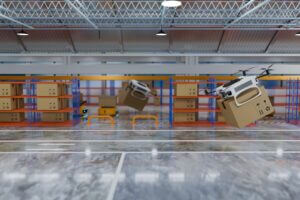[vc_row css=”.vc_custom_1697527753462{background-color: #efefef !important;}”][vc_column][vc_column_text css=”.vc_custom_1697527743685{margin-top: 10px !important;margin-right: 20px !important;margin-bottom: 10px !important;margin-left: 20px !important;}”]
Mechanization, automation and robotization are linked to the introduction of technological processes designed to improve the efficiency and productivity of activities. These 3 concepts are commonly referred to as "Mechanization".
[/vc_column_text][/vc_column][/vc_row][vc_row][vc_column][vc_column_text]
Mechanization suggests the use of machines to perform tasks previously carried out manually. Automation refers to the use of computerized and electromechanical systems to perform tasks without direct human intervention, in order to speed up processes, improve precision and reduce errors. Robotization involves the use of autonomous machines capable of performing complex and varied physical tasks, where the robot is able to make decisions for itself. This marks a shift from a "Person to Goods" organization, in which the operator moves towards the product, to a "Goods to Person" organization, in which the product is transported from its storage area to the operator. Reducing human movement naturally increases productivity.

The main advantages of mechanization
Increased efficiency :
Automated systems perform repetitive, labor-intensive tasks faster and more consistently, increasing overall operational efficiency in terms of performance quality, turnaround time and reliability. They also reduce the time spent on non-value-added activities.
Improved productivity :
Mechanization means faster order processing, which in turn means higher warehouse productivity and shorter delivery times.
Reducing labor costs :
Although the initial costs of implementing an automated system are high, the reduction in manpower requirements means significant savings in the long term.
Increased reliability :
Automated machines are less prone to errors, which improves stock and shipment reliability.
Efficient use of space :
Automated systems are designed to use available space more efficiently, making full use of warehouse height and optimizing product layout.
Improving safety and working conditions :
The introduction of machines generally improves working conditions by eliminating certain repetitive, arduous or dangerous tasks for teams.
[/vc_column_text][/vc_column][/vc_row][vc_row][vc_column][vc_column_text]
Disadvantages and Risks
Although automation and robotization offer many advantages in logistics, they also entail constraints that need to be taken into account and analyzed as part of the project.
High costs :
Setting up such equipment can be extremely costly. Staff training and setting up the appropriate infrastructure, automated conveyor systems... represent a high initial investment that is difficult for small businesses or low-margin warehouses to bear.
Complexity of integration and implementation :
Introducing mechanization into a warehouse requires careful integration with the company's existing processes, which can lead to operational disruption. Harmonizing automated systems with other aspects of the supply chain is often a technical challenge, and requires specialized training for staff.
Maintenance and reliability :
Mechanized systems require regular maintenance to operate at peak efficiency. Mechanical breakdowns and their repair cause costly downtime and disrupt warehouse operations.
Limited flexibility :
Mechanized systems are often designed for specific tasks, and are much less flexible than manual operations in the event of major fluctuations in demand or changes in the range of products managed. Implementing mechanization often requires a complete overhaul of logistics processes and warehouse organization.
Technology dependency :
The mechanization of logistics makes a company dependent on the specific technologies used. In the event of a major breakdown or malfunction of automated systems, the company is faced with major disruptions and delays.
Impact on team composition :
Managing mechanized systems requires specialized skills in programming, maintenance and supervision, which the company must necessarily acquire. Conversely, mechanization reduces the need for unskilled workers.
The special case of subcontracting :
When a company manages its logistics internally, it is the only party involved in the notion of the duration and ROI of mechanization. On the other hand, a company's logistics subcontractor is always subject to contract renewal (generally for 3 years), and will therefore be somewhat reluctant to commit to a heavy investment without certainty, bearing in mind that the average ROI of mechanization is 3 to 5 years.
 [/vc_column_text][/vc_column][/vc_row][vc_row][vc_column][vc_column_text]
[/vc_column_text][/vc_column][/vc_row][vc_row][vc_column][vc_column_text]
How to successfully mechanize?
Avoid over-mechanization
The main pitfall to avoid is mechanization, which leads to a loss of agility, particularly in sectors where the products sold can change rapidly (limited editions, for example) or vary according to the season.
Implementing efficient automated processes requires a thorough analysis of workflows. The type of products, the layout of storage areas and workstations, and the role of personnel in the overall process all need to be taken into account before automation is implemented.
Each warehouse is unique, depending on its configuration, organization, surface area and the type of products it handles. The mechanization of certain processes may be appropriate in one warehouse, but inappropriate or even unfeasible in another.
Validate the benefits and scope of warehouse mechanization
Identify eligible product ranges, as solutions cannot handle items over a certain size. In this case, these products must be stored in dedicated areas. As soon as a product does not fit into the mechanization processes initially planned, the flow must necessarily switch to downgraded mode, with manual handling, and a consolidation process must be implemented, incurring additional costs in terms of surface area, time and manpower. This non-mechanized process wastes time and reduces productivity and quality of service.
Analyze the structure of the orders to be served, as reasoning by order is not always relevant for orders comprising mostly few lines and/or few quantities.
Take into account the daily peak in activity, which may be concentrated in a relatively short time slot. In this case, the mechanized solution is likely to be oversized over a good part of the operating range, and the organization of production into 2 or 3 shifts will not always be applicable, which will have an impact on the overall cost of the system.
Take on board the fact that mechanization is not the miracle solution to all logistics issues, particularly given the speed of robots and the nature of the products handled. Instead, mechanization should be seen as a support that facilitates warehouse production. Consequently, it is often necessary to imagine a mixed warehouse comprising mechanized and non-mechanized modules.
Incorporating teams and future prospects
A warehouse mechanization project entails a profound change in working methods and habits. Teams need to be involved from the earliest stages of the project. Firstly, to reassure them that their jobs will not be affected, but also to explain the positive impact that mechanization will have on their daily lives.
It's essential to consider the durability of the installation, which must be able to adapt to changes in the items handled by the warehouse (size, weight, packaging, etc.), particularly in the case of a warehouse dedicated to e-commerce.
Despite the productivity gains it brings, it must be integrated into the overall management of the company, and be accompanied by ongoing reflection on theadjustment of logistics processes to meet the company's evolving operational and commercial challenges. What's more, the ROI result will be very different if we take into account the entire chain, and the investments that automation avoids when the business expands. For example, by increasing storage height and densifying space, a warehouse opening can be avoided by doubling or tripling storage capacity compared with a conventional system.
[/vc_column_text][/vc_column][/vc_row][vc_row][vc_column][vc_column_text]
Piracy is an underestimated risk:
The major risk for a fully or highly automated warehouse is a global and lasting computer breakdown. In this case, production ceases, goods can no longer be delivered, and the company's entire supply chain grinds to a halt.
Apart from a computer bug in the driver software, a more insidious peril threatens supply chains: cyber-attacks that paralyze all or part of systems by corrupting or encrypting data. Over 75 major transport and logistics companies have been hit in the last 3 years, and have been subject to ransom demands to free their data.
It is therefore vital that a Business Continuity Plan accompanies the mechanization of a warehouse, particularly if the company has only one site.
In short, successful mechanization requires :
- Evaluate warehouse functions
- Be consistent with corporate strategy
- Identify value-creating functions and flows
- Thinking beyond the warehouse and integrating likely future developments
- Plan for continuous improvement
- Drawing up a Business Continuity Plan
- Setting up a scalable organization
So, do we mechanize?
Of course, it's perfectly logical and desirable to make use of the possibilities offered by technology, but this must be done in a reasoned, rational and, above all, evolutionary way.
In an ultra-changing, mobile environment, it's important to remain agile, and not be locked into rigid equipment and mechanized organization.
[/vc_column_text][/vc_column][/vc_row][vc_row css=”.vc_custom_1682523226414{padding-bottom: 15px !important;background-color: #efefef !important;}”][vc_column][vc_column_text]
Setting up the right mechanization for your business?
Given changing consumer expectations and the challenges facing the supply chain, mechanization is becoming a major issue that needs to be addressed to improve warehouse efficiency and deliver on the customer promise.
Would you like to set up the right mechanization for your business, or just discuss it?
[/vc_column_text][rt_button_style title=”Contactez-nous” link=”url:https%3A%2F%2Fwww.universretail.com%2Fcontact%2F|title:Contact” animation=”fadeInUp”][/vc_column][/vc_row][vc_row][vc_column][vc_column_text]Sources :
Square: Mechanization, Automation, Robotization
SSI Schaefer: The Guide to Intralogistics Performance
Scallog : The Guide to Intralogistics in France[/vc_column_text][/vc_column][/vc_row]

